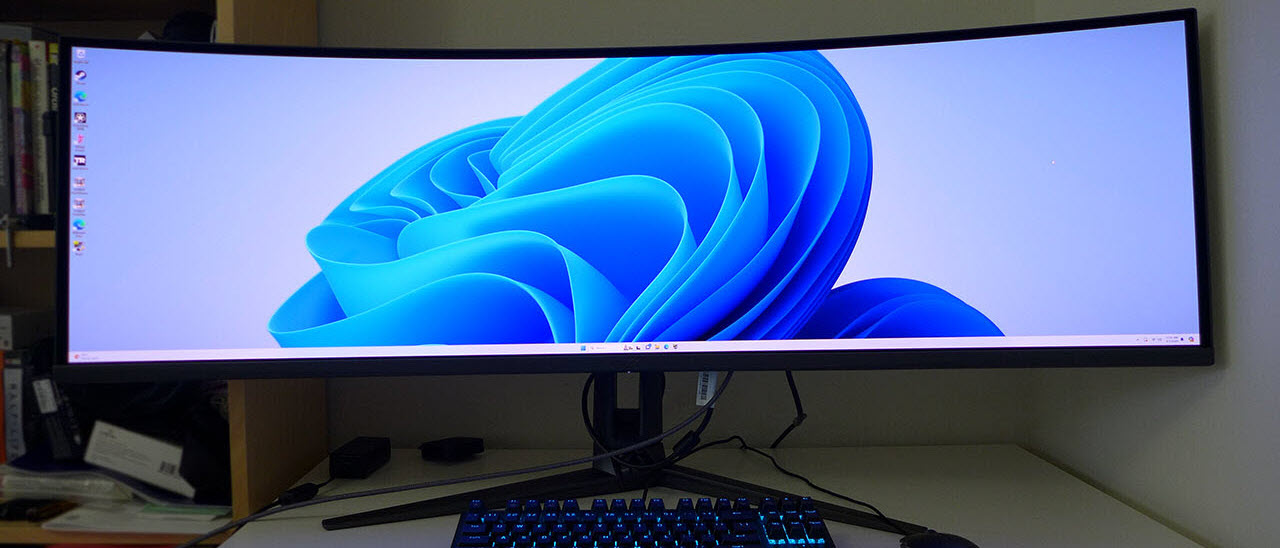Why you can trust Tom's Hardware
Our HDR benchmarking uses Portrait Displays’ Calman software. To learn about our HDR testing, see our breakdown of how we test PC monitors.
The PG49WCD supports HDR10 content with a seamless switch to HDR mode. There are four picture presets available, and you can adjust brightness, which is something few HDR monitors allow.
HDR Brightness and Contrast
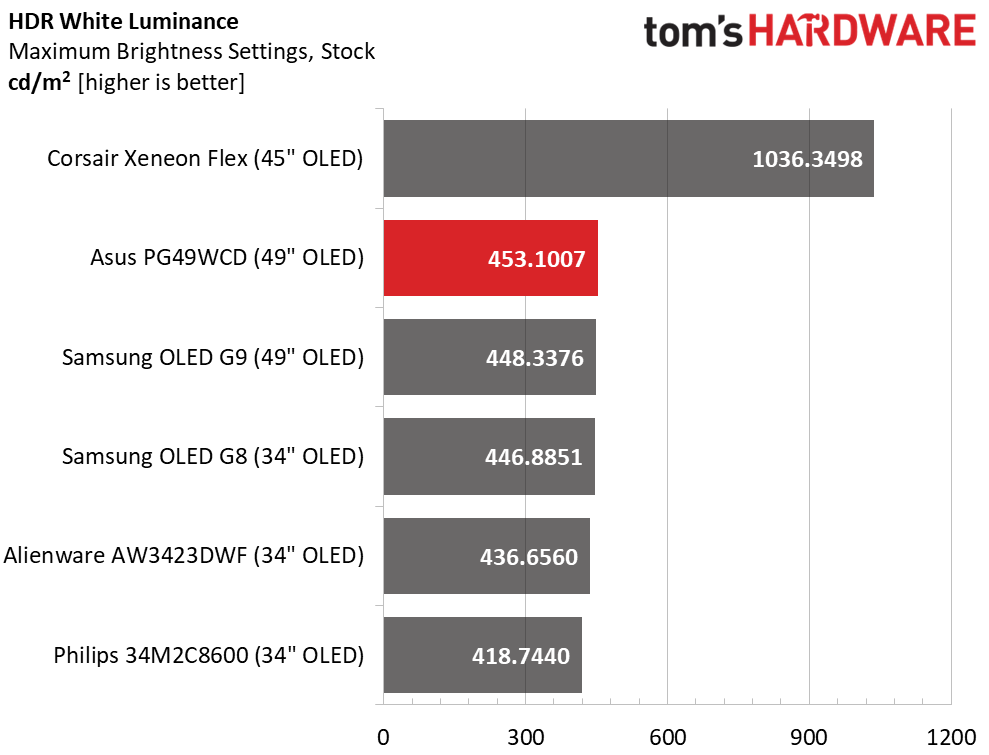

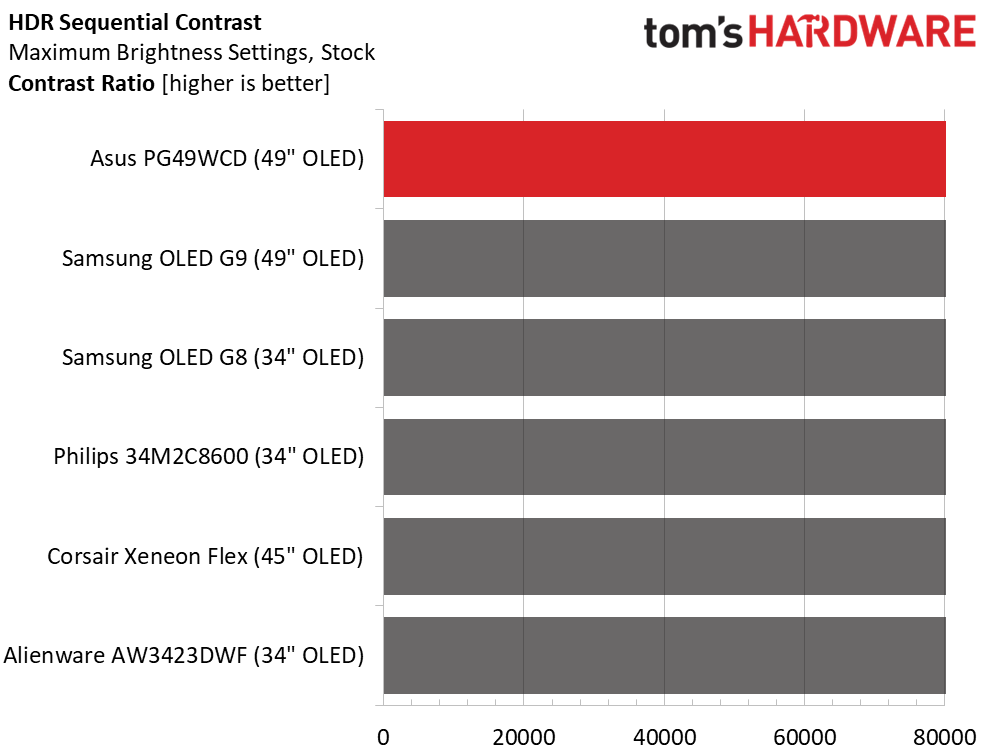
The PG49WCD earns its VESA DisplayHDR 400 rating with a 453-nit measurement. I used a 25% window for this test. Asus claims 1,000 nits for a 3% window and given these results, it tracks. Like SDR mode, black levels can’t be measured because the pixels are shut off. The mode I tested is called “HDR 400 True Black” for good reason. You can also choose Console, Game or Cinema, but HDR 400 is the best option. I had no need to adjust brightness for my environment, but you can turn that option on in any of the HDR modes.
Grayscale, EOTF and Color
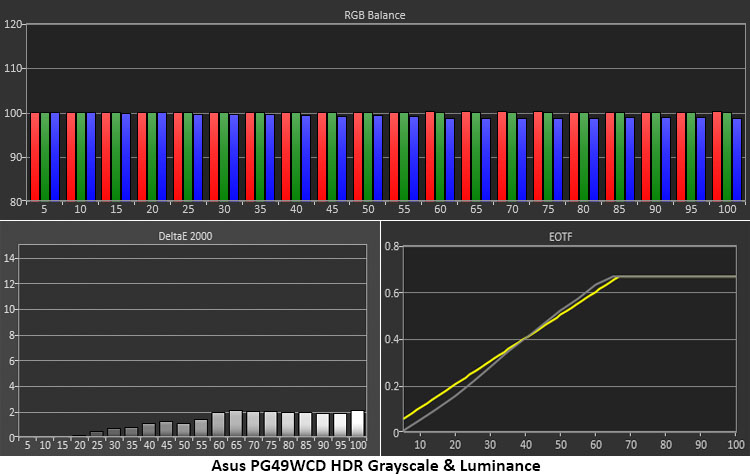

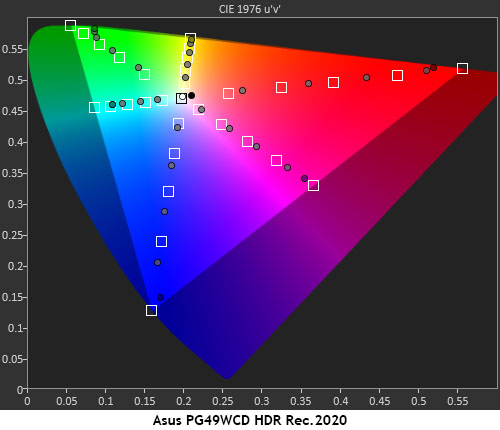
The PG49WCD’s HDR grayscale tracking is spot on, with no visible errors anywhere in the brightness range. The EOTF tracks close to the reference as well. Darker steps are slightly lower than spec, but I saw no negative impact on the image. Shadow detail was clearly rendered. The tone map transition is at 65% which is correct for the measured black and white levels.
With such a large gamut available, the PG49WCD excels in the HDR color tests. The DCI-P3 gamut is exceeded in all areas but not too over-saturated. Linear saturation tracking means that color is vivid but not over-balanced, and detail is maintained. Hue points are on-target as well. In the Rec.2020 test, color is similarly over-saturated until the limit which is around 90% for red and green. If you watch HDR content mastered to Rec.2020, it will look very close to what you’d see on a reference monitor that fully covers that gamut.
Test Takeaway: The PG49WCD leverages OLED’s infinite contrast and deep blacks with more color than its competition. It accurately renders all the DCI-P3 gamut and then some. And it comes closer to Rec.2020 than any other OLED. It’s hard to imagine better HDR than this. Superb!
MORE: Best Gaming Monitors
Get Tom's Hardware's best news and in-depth reviews, straight to your inbox.
MORE: How We Test PC Monitors
MORE: How to Choose the Best HDR Monitor

Christian Eberle is a Contributing Editor for Tom's Hardware US. He's a veteran reviewer of A/V equipment, specializing in monitors. Christian began his obsession with tech when he built his first PC in 1991, a 286 running DOS 3.0 at a blazing 12MHz. In 2006, he undertook training from the Imaging Science Foundation in video calibration and testing and thus started a passion for precise imaging that persists to this day. He is also a professional musician with a degree from the New England Conservatory as a classical bassoonist which he used to good effect as a performer with the West Point Army Band from 1987 to 2013. He enjoys watching movies and listening to high-end audio in his custom-built home theater and can be seen riding trails near his home on a race-ready ICE VTX recumbent trike. Christian enjoys the endless summer in Florida where he lives with his wife and Chihuahua and plays with orchestras around the state.
-
edzieba For OLED panels (or LCD panels with backlight modulation) it'd probably be better to chart grey contrast rather than black contrast - the ratio between the maximum and minimum possible nonzero illumination level. Black contrast with a panel that can turn off a pixel/zone for 0-level will always end up with a divide-by-zero issue and a completely worthless chart. Grey contract (full brightness over minimum displayable brightness) actually gives you a useful measure of real world contrast.Reply
e.g. a screen that can produce 0 nits at 0 input level, 1 nit at an input level of 1, and 1000 nits at an input level of 255, will have much higher perceptual contrast than a screen that will also produce 0 nits at 0 input level, but produces 50 nits at an input level of 1 and 1500 nits at an input level of 255.
The naïve max-brightness-over-zero-level charts are about as helpful as the old 'dynamic contrast' measures manufacturers liked to slap on monitors with backlight modulation (where a TN panel could magically produce a 80,000:1 contrast ratio). -
brandonjclark How would you compare this monitor on "versus" comparison, buy this or that, to the Dell Alienware AW3225QF, readers?Reply -
oofdragon Why these companies keep wasting time and resource launching these huge things not up to date with tech? 144hz is like 10 years ago literally, the minimum now is 240hz or gtfoReply -
subspruce Reply
also this monitor needs 2 people for transport, getting a friend (if you haven't already) or a partner will be a great move if you ever want to move house.oofdragon said:Why these companies keep wasting time and resource launching these huge things not up to date with tech? 144hz is like 10 years ago literally, the minimum now is 240hz or gtfo
